Mandala
Various peoples movements we were connected with, when engaged beyond the apparent issues of economic loss and other concerns, we recognised, how deep it was also a struggle to preserve a relationship with earth, which is also spiritual. A kind of bodily holiness, rooted in Earth and Life. It affirm and celebrate the interdependent connections not only between humans and other living forms but also with inanimate forms. For most in these communities the animate and inanimate were part of the same reality. Every matter came alive, pulsating and radiating life. Be it soil, rocks, trees, water, decaying leaves, elements, seeds, sprouts, all were part of one continuum.
Theirs is a world of basic economy, pragmatic outlook and abundance of life, and a sense of beauty grounded in it. Abundance of life is different from wealth we accumulate. We still survive today in spite of the grave ill deeds and indulgences that humans have commited on earth is only because of this innate force of Life at work. You cut a branch, many new branches will sprout, you cut the tree, from roots it will sprout far away from its source. To sprout a few seeds, a tree produces tens of thousands. Beauty and joy is found in simple and functional things. It is preserving, not wasting. The foundational force of earth is love and reverence. This is different from market or political opportunism.
The mandala is designed to initiate one into this world of bodily holiness and spirituality that embrace life. The mandala with the JackFruit tree and the well together holds and reveal a primal world, almost archetypal in nature. For a person who loves to sit and reflect this space would take her beyond both her infancy and death.
A friend of mine, listening to our desire for such a space, offered to support it financially. Since then I have spent nearly two years for this space to unfold. There are already established architectural languages among all religious communities for places of prayers and reflections,. But I did not want to rely on such principles. So waited for something to evolve, trusting the paths I have walked with tribals, the energy visthar's own places like well and jackfruit tree etc have gifted. I wanted this space, as we enter, help enter into a realm of ourselves, which otherwise is not known to us.
First I wanted to do it inside the well, a structure coming out of it. It was for financial reasons I started looking to connect it with the jackfruit tree, but it happened for the good. So the mandala in a way is also making the visitor to enter the well in a different light. In another light it is also like entering the root of a tree and reaching its canopy, its blossom. For the innermost space I appropriated the form of 'kudakallu' from Chermanangad near our village, vellattanjur. Architecturally it has an interesting form. It is like the canopy of the tree structure from a grove or the blossoming of any form, primal in nature. I would like to thank Jeet Ipe and his team for the structural advice.
Mandala is a sacred space for reflection on earth centered experiences which is symbolic, spiritual and transcending.
The sacred space is elementary. It is not a consolidation of religious thought and certainly not interreligious. This is a space where on can come and reflect on earth-centered experiences. And initiate a process of deconstruction. It is a space to contemplate the fragments of our identity that are humanly engineered. It is a place one can come to transcend the tenets that rule our mind and create space within oneself to allow the birth and death of different seasons.
To Look at Any Thing ( a journey through mandala)
The Jackfruit Tree
Looking at the size of the land occupied by the spread of the jackfruit tree, one would feel that an apartment complex could easily be raised on it. But a few minutes under the patchy shade, and you realize the sheer cruelty of such a thought.
The people who live around and feel connected to the tree, how would they react to such a suggestion?
A few years ago one of my father's friends, who lived in Annapalya (where most houses don't have compounds and the only windows are those that look into the road), suggested that we replace the two sapota (chiku) trees in our garden, with a double story row of rooms. He certainly wasn't aware that, apart from the precious lung space, the tree allowed us some unusual neighbours, which included, a praying mantis, a chameleon, squirrils, big sized red ants, fruit bats at night, and at times crows, koels and sunbirds. This friend pointed out that the extra rooms could get us a handsome rent equal to my father's pension. He was softer on the tall coconut trees though; they could easily be intergrated into the structure through holes in the ceiling. He even offered to show us houses of his neighbours who had saved their trees by this ingenuous method.
The great Sir Visvesvaraya, a strong proponent of industrialization, was taken over by similar sentiments at the sight of the thundering waters of the Sharavathy at Jog Falls. (I wonder what he would have said of this jackfruit tree.) Seeing the waters wasting away untapped to the ocean, he gave voice to the enormous potential for harnessing electricity from the river. Now the waters have been tamed and they thunder only as much as the dams upstream allow them. (Strangely enough this happens only when VIP's visit the falls!) And most times they are allowed only a trickle, silent and unseen, even when the monsoons are raging.
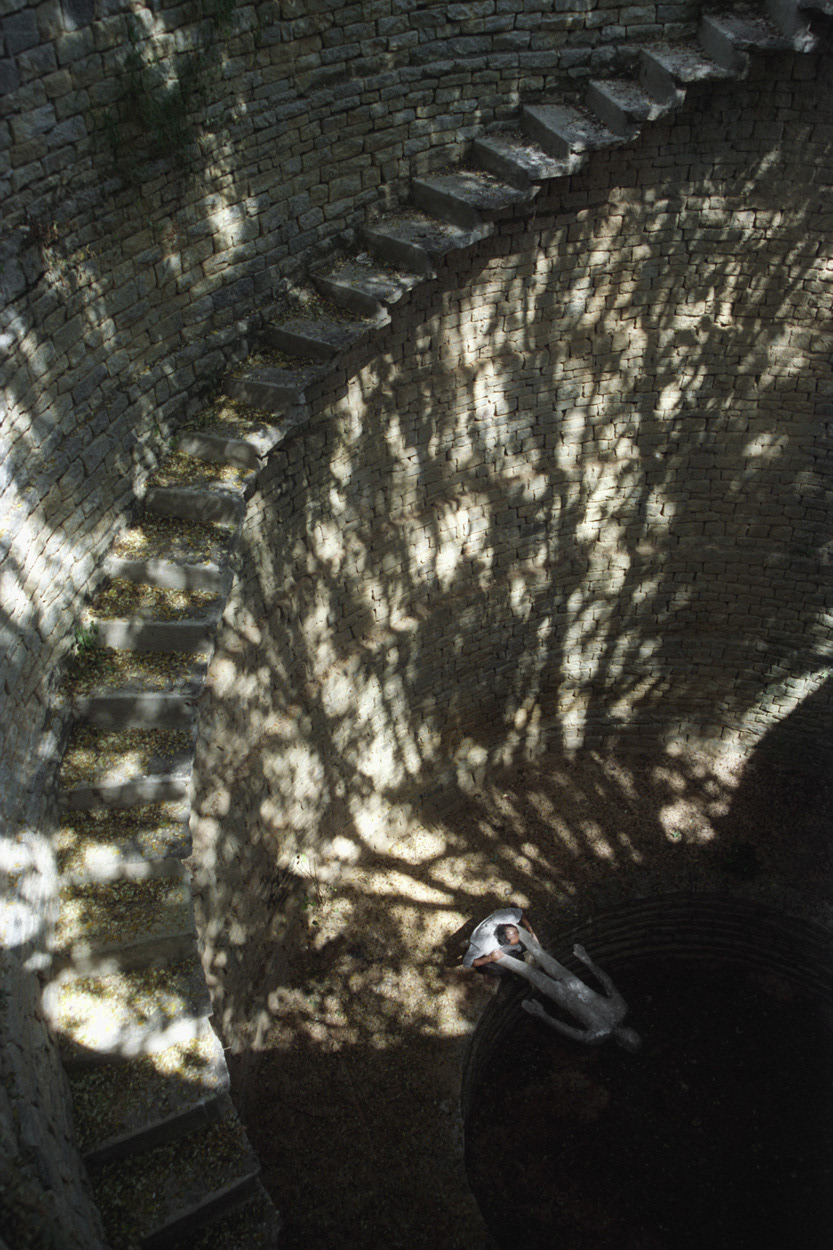
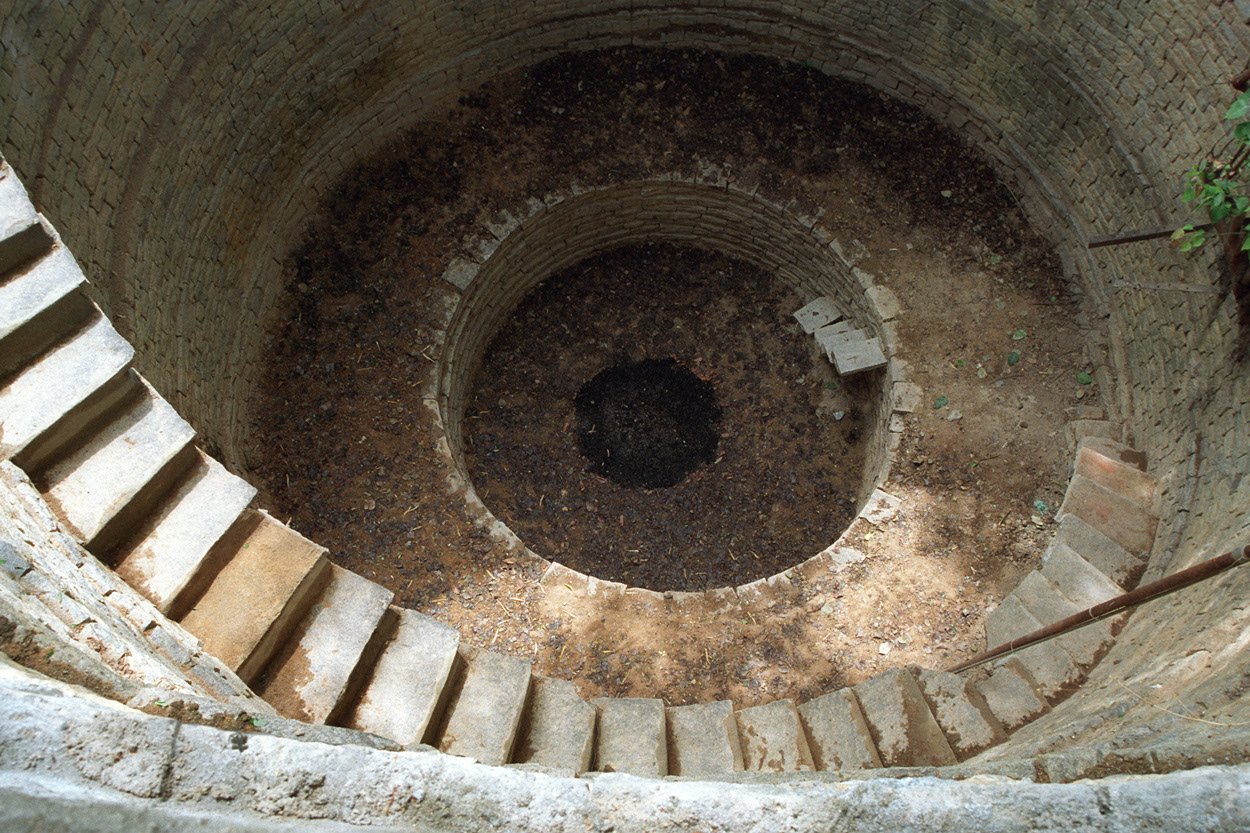
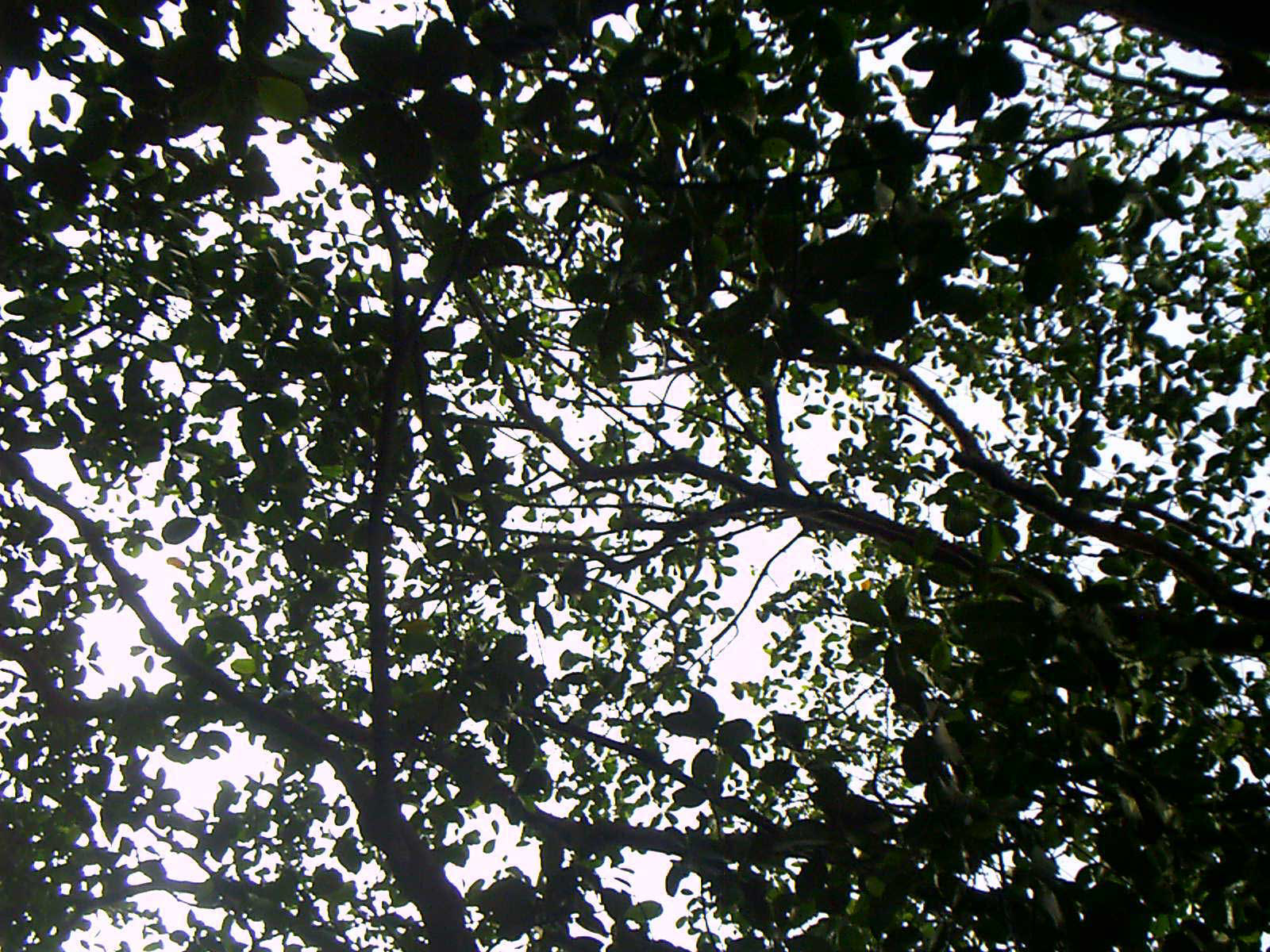
Location
A few kilometers closer to the city and in private hands, an apartment complex would certainly have been the fate of this tree. But, unlike many others, this one is just enough on the periphery and with people who regard it for what it is and engage with it so that its essence as a tree is enhanced and celebrated. Located in Visthar, 15 km from MG Road, further down Lingarajapuram, the tree is now part of a meditation and discussion space named 'Mandala'. Designed and conceptualised by C F John, Mandala enshrines the philosophic outlook pursued by the people in Visthar.
The canopy of this tree isn't grand or overwhelming; yet its coolness and dappled shade envelop you with protectedness. Small clay pots and drawings are suspended from the branches through strings that give the impression of roots reaching for the ground. The tree betrays vulnerability too. Small bits of the bark have peeled off and show bright orange yellow wounds with no attempt to hide them. They are not abnormal or unnatural. Nor a disease. To behold the sight of the massive fruits is to suddenly become aware of the abundance and fertility that nature is capable of.
The peace seeps into you. You don't have to try hard. The tree itself seems to be resting peacefully with many branches growing hardly a few feet from the ground and running along parallely - an open invitation to climb and be one with the soul of the tree. In such a setting one can't but feel one's body winding down from the fever pitch of the city, the blood pulsating with the the tree's sap and the heart acquiring a slow and steady rhythm in tune with the tree. One is reminded of the fact that Buddha didn't just strive at controlling his desires but chose the environment he wanted to live in. Nature perhaps was the key. (Buddha was also careful about the tree he chose. Though one doesn't hear of jackfruits falling, it would still need some nerve to sit 'peacefully' under a number of them hanging precariously from the trunk.)
Mandala
On the western periphery of this tree, built in line with its stem and the sun's trajectory, is a small cottage with red tiled roof. In between is a brick-lined semicircular space in the middle of which we see an earthen pot placed in the earth. The tree, pot and the building (and the sun) together complete the Mandala.
Made from laterite blocks brought from Kannur and by traditional skilled masons from Kerala, the colour of the building matches the orange flesh of the jackfruit tree. One is drawn to its un-'awe inspiring' proportions with a sense of interiority and introspection. The front door when closed reveals a burnt surface with an impression of a large pipal tree leaf. The door, one realizes later, is made irrelevant by the fact that the space is open from the other side.
Apart from from Jeet Ipe, who gave structural advice for the building, many artists, craftspeople and workers have contributed to the making of Mandala. As you enter you are welcomed by two medium-sized windows facing each other with strips of recycled paper laminated between glass windowpanes. Done by Jenny Pinto, the one on the right is an enlarged fingerprint and the other has patches of strips weaved together and placed alongside pieces of coconut fibres that show a natural version of the same pattern. From these ordered works one is introduced to frames where the play of order and disorder is much more vigorous. Apart from the works placed on the windowpanes, you could adjust your gaze to focus on the trees and the growth outside, or on reflections of glass tiles of the roof.
A Journey
Mandala is an invitation to a journey. It's a journey where you find yourself looking keenly at your own responses to the space and the artwork. These responses could be thoughts, feelings or other body sensations. Mandala aims to facilitate this journey with gentleness, care, and beauty. The atmostphere inside has been designed for this - a play of light creatively directed through curtainless windows and through coloured glass tiles in the ceiling (tile patterns conceived by Micheal, a Swiss artist who specialises in lighting design). From the serene outside that helps you relax and clear your mind, you are taken deeper and deeper (as in a cave) - to be able to look at things for what they are, and then to begin to understand the relationships with time, space, history and everything that impacts us and constitutes our world.
The immediate space (the largest in the structure) again has six windows and houses art works by many other artists who have used a variety of natural media. Two of the windows have wooden frames cut from the same block. By retaining its 'deformity', the wood reveals the structure of its parent tree and adds texture and dynamism to the building. Being discarded as waste, John tells us, it was more difficult to procure these pieces than the clean-sawn perfect ones that can be crafted to any desired shape. One soon realizes that material objects in the building have been treated with care and their original essence maintained as far as possible. They in turn reward the larger entity with beauty and diversity. Each object, even while existing as part of a larger structure, attracts you by its own identity. The wood in the window is hence not cut and chisseled into shape and painted up, its material identity completely obliterated to give way for the larger purpose of the window. Nor is the window just a rectangular hole that fits the larger purpose of the building... they perform their roles in the overall scheme in equal measure, yet they are themselves too - part of a thriving democracy of materials.
The contrast with modern conventional buildings is not overwhelming until one starts to think about it. The cement and the bricks that largely constitute my present house are, if seeing is believing, non-existent! Hidden behind a vaneer of paint, by shutting them out of our awareness, we seem to have closed ourselves into neat little cocoons. Even the constituents of the paint that envelops the house have little of their orginal selves, and would need much research to understand their ingredients.
The wood used for the roofing of Mandala on the other hand has been crafted clean with a precision that is close to a miracle when one realises that the craftsperson used no more than a pencil and a small sheet of paper to conceive all the grooves and intersections. Put together by Biju and his team, traditional craftspeople from Kerela, the entire structure holding the tiles in place took two months to be made to size. Following which it took just a day to put it in place as the ceiling. The matrix of beams, rafters and other pieces of wood that go into making the structure have minimum number of nails driven through them and very little glue as well. Jungle wood (essentially neem and other commonly available trees) is prone to termites and other pests and hence has been treated with oil left over from roasting cashew nuts.
The other four windows in the main space face each other and constitute works by C F John and Raghavendra Rao. Apart from lithograph prints, these again have natural matter embedded on recycled paper pulp on the glass - things that would otherwise constitute waste - a film peeled from the stem of a banana trunk, decaying leaves, coverings of bean pods... Placed this way with light streaming in through them and revealing hidden patterns, these objects call out to you and, to use a phrase by Jaques Barzun, 'stir the senses to seeing'. One is not expected to look for the universe or eternity in them, or to be led into abstractions, and attach extraordinary meanings to them. They have been placed to just be seen for what they are, and their existence acknowledged and if possible celebrated.
The other four windows in the main space face each other and constitute works by C F John and Raghavendra Rao. Apart from lithograph prints, these again have natural matter embedded on recycled paper pulp on the glass - things that would otherwise constitute waste - a film peeled from the stem of a banana trunk, decaying leaves, coverings of bean pods... Placed this way with light streaming in through them and revealing hidden patterns, these objects call out to you and, to use a phrase by Jaques Barzun, 'stir the senses to seeing'. One is not expected to look for the universe or eternity in them, or to be led into abstractions, and attach extraordinary meanings to them. They have been placed to just be seen for what they are, and their existence acknowledged and if possible celebrated.

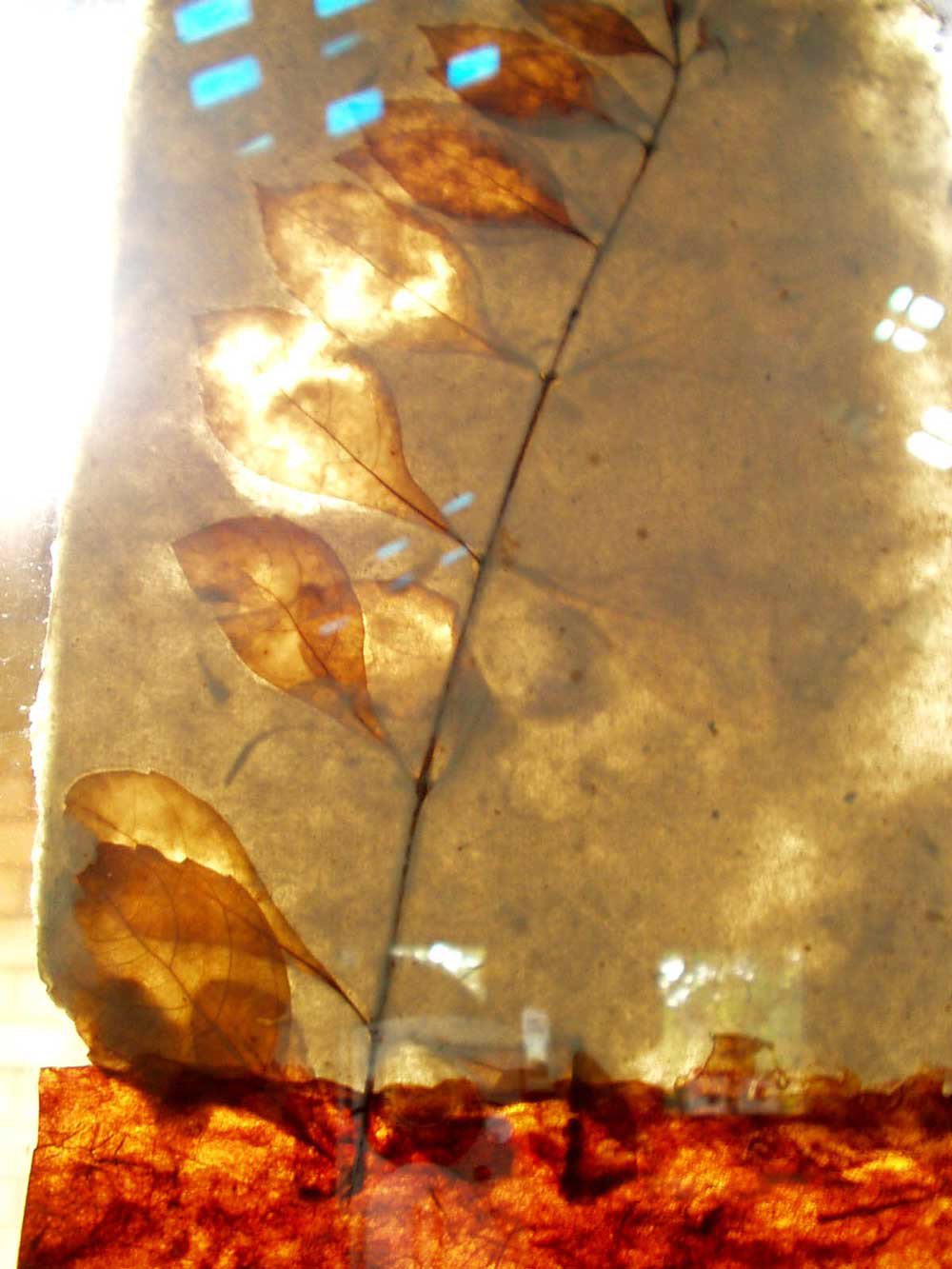
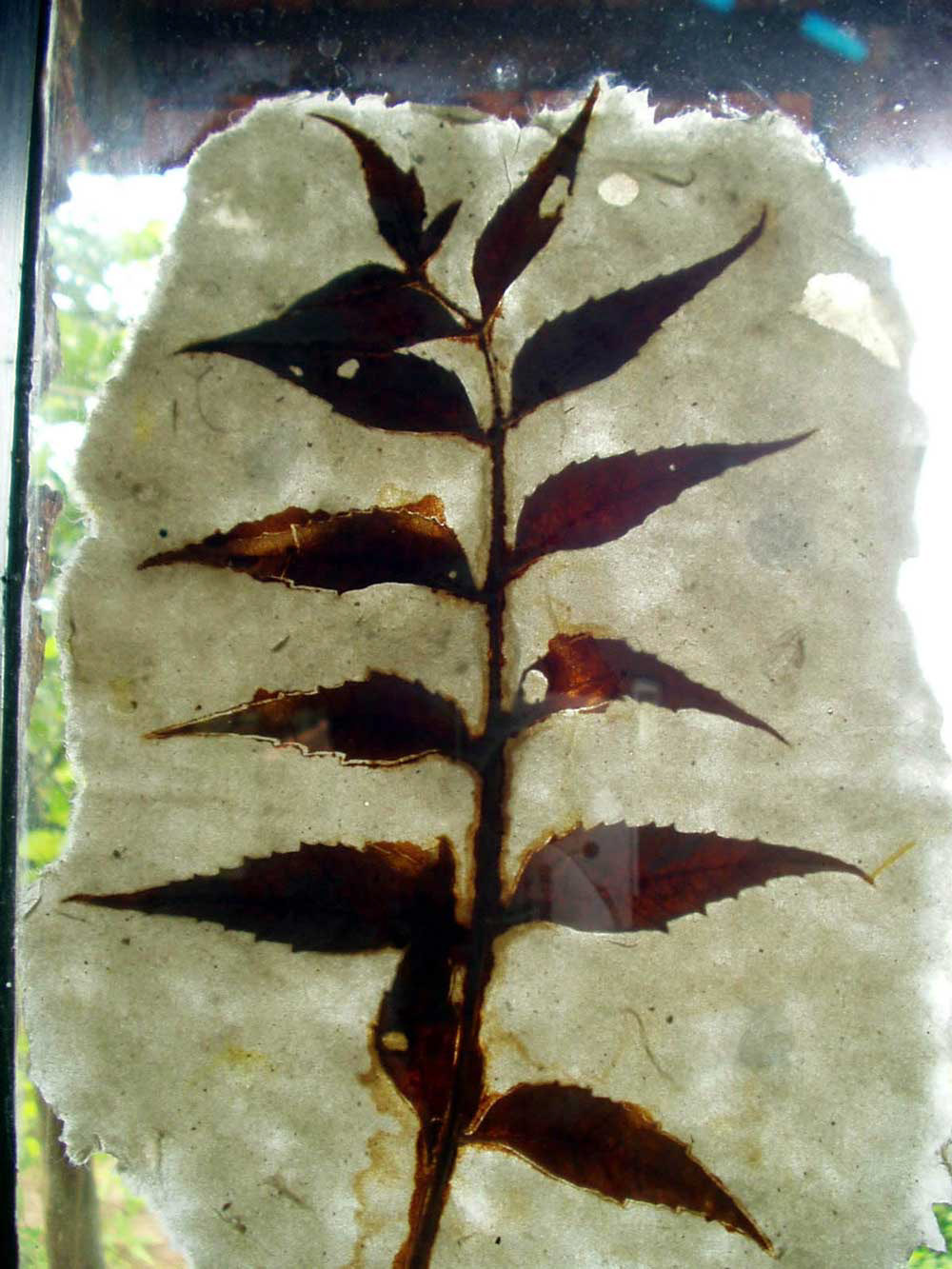

Interconnection
The place evokes intense emotions and after a while your thoughts touch the most intimate areas of your life - you are left confronting the very basic and at the same time the cosmic. As you move from one space to the other you find you are journeying through your being, discovering and in a way taking stock of your diverse selves and trying to find connections between them. This is not done through enquiries into the soul or by invoking heaven and hell. Mandala presents the most ordinary things before you and nudges you to confront what is there. One cannot but give one's attention to the brick, the leaf, the light through the roof lighting up specks of dust, the cool red oxide floor, the texture of art works and similar minute details.
If one were to look similarly at the basic items of our daily use one would be struck by one's ignorance of them. The changing modes of supply and demand in this globalized world have left us in a state where it is impossible to know anything more than what advertisements or labels tell you. For example, I have little idea of where, how and who produced the milk I consume daily; I am not even sure if it is from cows or buffalos. The same is true of the jams, marmalades, mayonnaise, sauces, masalas and other exotic eatables I pick up from the supermarket. Or for that matter, my clothes, footwear, the stationery I use... Needless to point out the irony of being in the midst of the information revolution. In constrast with our ignorence about essential details, we are constantly under the onslaught of numerous consumer products, our minds cluttered with hundreds of brandnames that create a life and ethos about us.
The experience of being in Mandala was closest to a meditation technique I had learnt some years ago, where one almost clinically examines the body for sensations erupting in it. Here I was acutely aware of the thoughts passing through me and also aware of body sensations. At the same time, rather than being cut off, I was engaging with the world with an intensity rare in my day to day being.
One thing that Mandala doesn't allow is stridency - in movement or thought. There are no easy answers. To enter the building you have to climb up, and to get to the next space you have to go down. And you have to be slow. The structure doesn't block your movement, rather it forces grace onto it. There are three staircases going down, separated by two platforms that one has to skirt around. Likewise, Mandala entreats you to acknowledge the truth and legitemacy of other worldviews. Mainstream perceptions are deconstructed to reveal many truths. One can hence say with conviction that urban living, wars, religious fanaticism, information technology, caste identities, marriage, corporate ambition and multinational companies and such like, needn't be the only realities; that there are possiblities arising out of other ways of thinking which are in tune with the earth.
The first platform you encounter is a bean shaped table with shelves under it. The idea of it being in the way to the next space is to counter the 'highway' mentality that reigns in much of our current thinking, where everything existing is cleared up to make way for something new - it may mean dynamiting mountains down for a road, or diverting or blocking rivers through a dam, uprooting communities and sometimes whole towns if they come in the way of a mega project, clearing away vast tracts of forests... one could go on.
The shelves and wall space in Mandala are to be a repository of art objects, poems, songs, and books that celebrate life in all its forms and engage with the animate and inanimate world with equal respect.
To Look at Any Thing
The second platform is slanted and has a glass casing over an inverted pyramidal depression. The object inside it is not something someone has created. Instead, guests are free to share natural objects that they have found in the vicinity. As much as there is an attempt to look at the way an artist treats material objects for creating objects of art, there is an attempt to look at the way a viewer looks at them. This perspective tries to break the exhibition mode of lateral viewing. The viewer is not someone who views art like a consumer; the viewer is part of the process - the seer and the seen are not different entities within an unequal relationship. There is engagement in seeing, and since the objects are placed below, one has to make a genuine effort at it - a re-enactment of the pre-natal perspective when the child sees most things as it finds them on the ground; or perhaps like a search, as animals go looking for food on the ground.
American poet John Moffitt suggests a similar engagement in the poem To Look at Any Thing:
To look at anything,
If you would know that thing,
You must look at it long:
To look at this green and say
"I have seen spring in these
Woods," will not do - you must
Be the thing you see:
You must be the dark snakes of
Stems and ferny plumes of leaves,
You must enter in
To the small silences between
The leaves,
You must take your time
And touch the very peace
They issue from.
If you would know that thing,
You must look at it long:
To look at this green and say
"I have seen spring in these
Woods," will not do - you must
Be the thing you see:
You must be the dark snakes of
Stems and ferny plumes of leaves,
You must enter in
To the small silences between
The leaves,
You must take your time
And touch the very peace
They issue from.
The next chamber is dug into the earth and is like an underground balcony where you see grass growing at your eye level - a perspective perhaps only grave diggers and soldiers in trenches are priveleged with. The depth is exactly six feet. With a sitting space all around, it is ideally suited for a small group gathering, and precautions are taken to keep it congenial - a traditional Native-American instrument made with feathers and antlers called the 'dream-catcher' is suspended from above to deflect good dreams and thoughts back at the people below. The sitting area is surrounded by the sky as reflected on the canal of water stored to grow lotus and other plants.
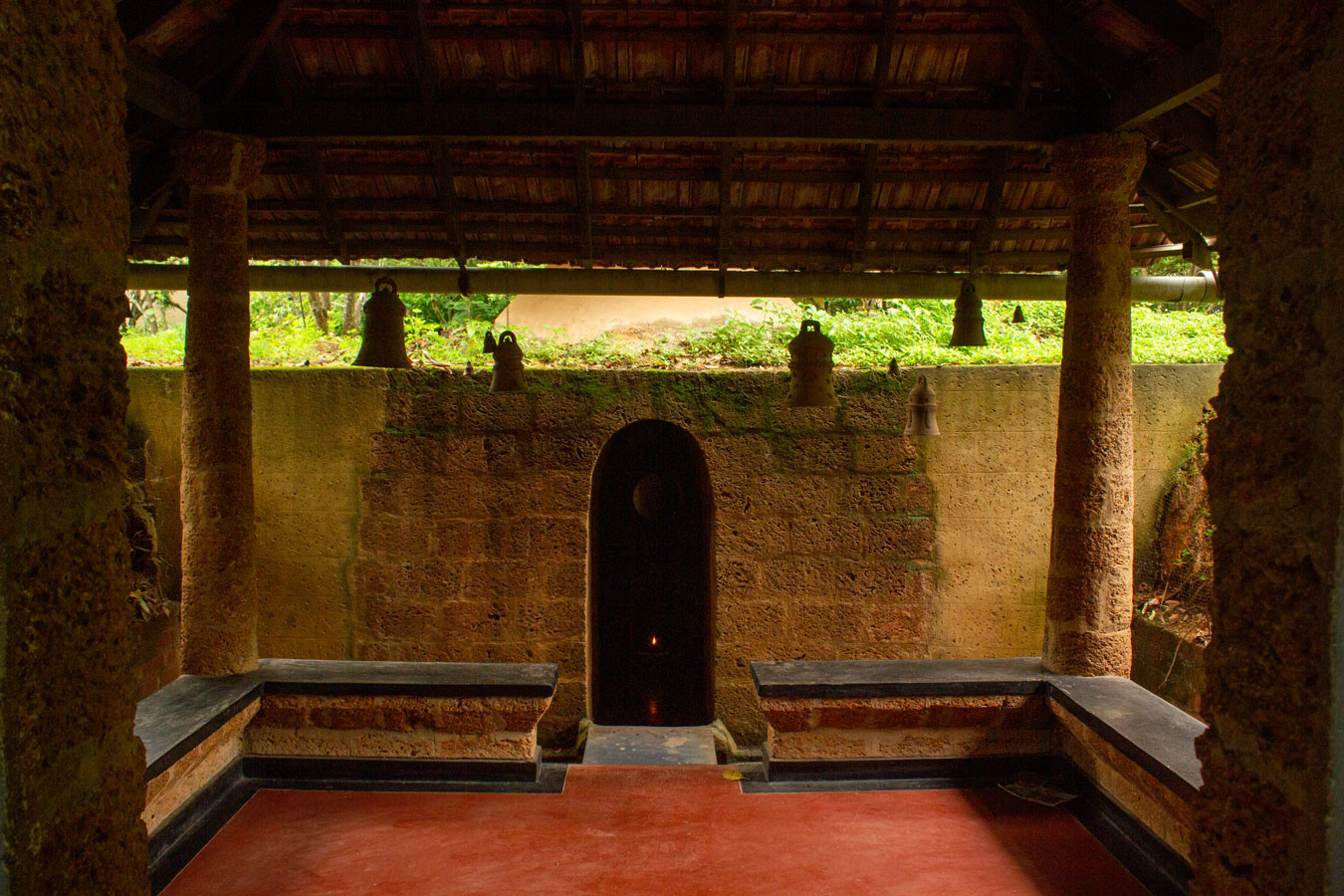
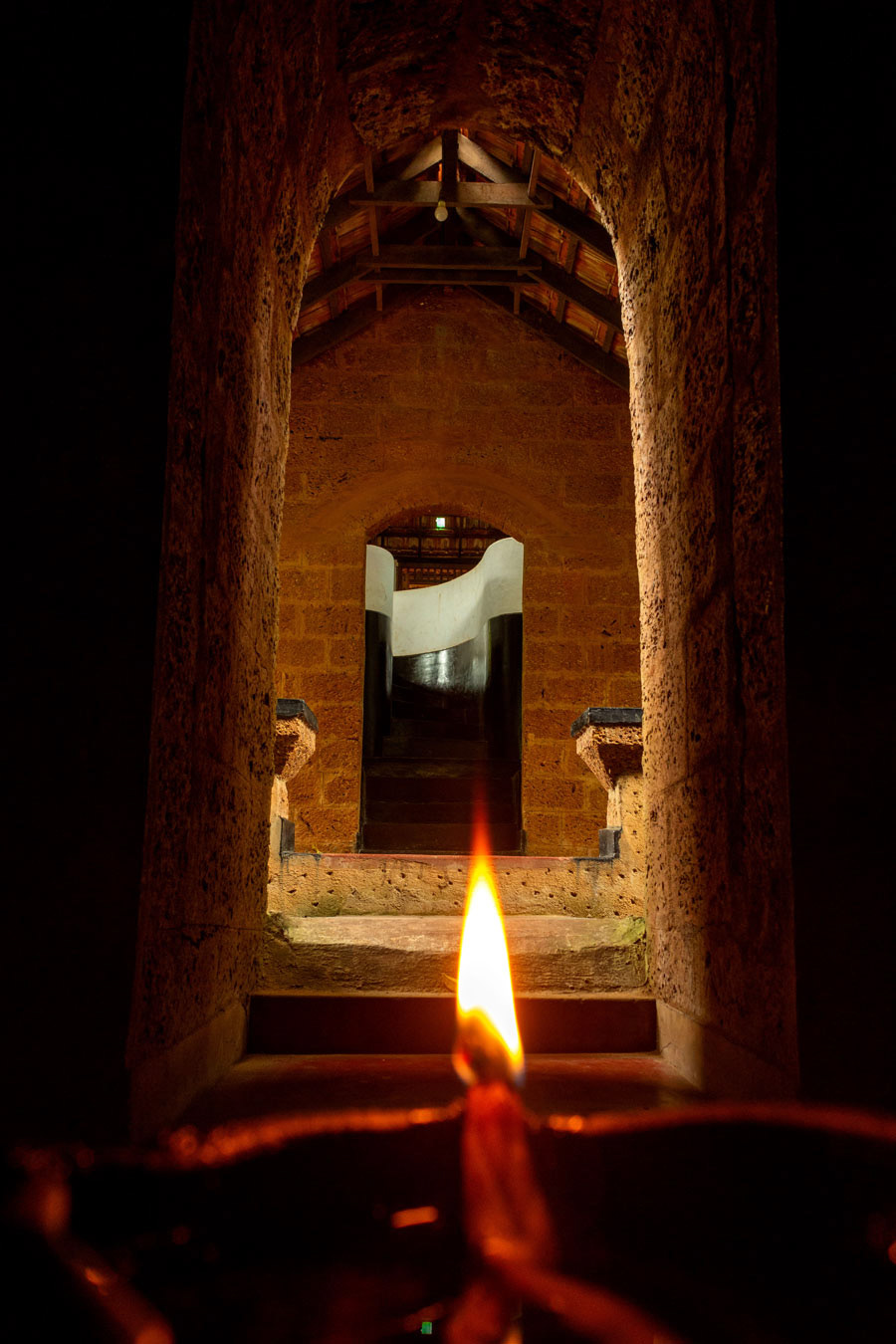
Discovery
At the end of the journey through Mandala, what you discover is none but yourself. The sanctum sanctorum - the final structure - is built into the earth like a cave and has an umbrella shaped disc balancing above it. As you bend down to look in, you see your own face on the mirror placed inside. And with the lamp placed behind the mirror, you are the hallowed idol. With just a suggestion of it in the outside, Mandala gently leads up to an interioty that offers a secluded private space with the possibility of finding connection with yourself, the forces of nature and the world at large.
It is not recommended that you enter this nestlike structure. As you look in, you find an assortment of thoughtfully placed lamps lighting up the inner space with shadows of khadi threads dancing on the walls. With much enthusiasm and effort, officials at the Khadi Village Industries Corporation (KVIC) donated the threads after procuring them specifically from a unit in Mysore. Suspended from these threads are clay receptacles with a variety of seeds, suggesting dormant life. The khadi threads have been chosen to celebrate human labour and the need for it in our lives - labour that connects human beings with the world, and involves creativity.
Origins
The distance from the city, and the quietness and serenity of Mandala offer seclusion and isolation. However, it is not intended to promote an escape from the world. Rather, it strives towards a spiritual vision that encourages one to make conscious choices. While, it may seem to deal only with timeless notions, in actuality its creation has been in the context of two important developments especially over the last few decades in India and the world at large.
On the one hand is the concern over destruction caused by mainstream development policies that are based on a narrow understanding of the earth and its resources. The vision of Mandala celebrates the communities that look at themselves as part of the earth and who seek harmony with it. In propagating their practices and their worldview, it exposes the limitation of the 'save the earth' program undertaken by the same institutions that are largely responsible for the earth's destruction. The 'man-centered' philosophy underlying such projects instumentalizes the earth yet again by arguing that the earth has to be saved not for itself but because it needs to sustain 'Man'.
The second concern is the rise of fascistic religious politics that uses one's need for spiritual transcendence for its own violent ends by fragmenting society along religious lines. The creation of Mandala is based on a serious enquiry to locate the connections between faith, spirituality and belief. Seeing little possibility of liberation among monolithic religions, or anything inter-religious, Mandala seeks to propagate a spirituality that is free of intitutionalized religious thought and belief. It is not religious bigotry but religiosity itself that is called to question. Instead of closed religious identities, Mandala explores a spirituality that celebrates the earth, and similarly renews itself. It is not limited to a single community, but rather belongs to the earth and all that inhabit it.
To those hungry for titilation and excitement, Mandala may have little to offer. It would hardly take a few minutes to tour the place and view its contents. One wouldn't visit it for new and excitings things to see and feel. Instead, the time spent there would open you to taste new ways of seeing.
At one point during the day, John offered me a tiny bit of a flower from a plant growing beside the window. I placed it on my tongue and found him observing me with a smile of immense anticipation. (I remember seeing a similar expression on the face of a 10-year old friend of mine who offered me a candy called 'Center-shock'.) The effect took over quickly and I wondered if it was I who was eating something or if something was eating me. I felt my tongue dissolve into the sour elements of the flower. The taster and the tasted seemed one.
By Kamaan Singh Dham